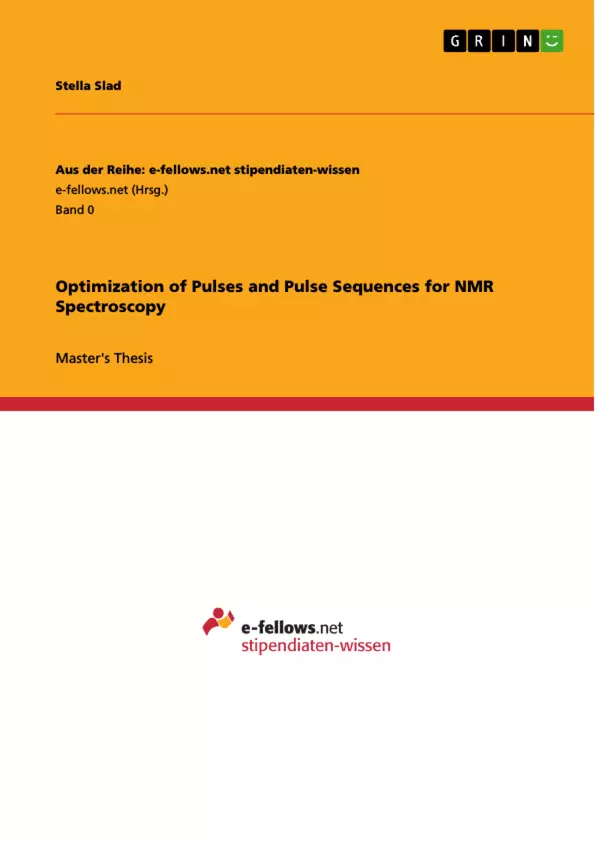Pulse engineering plays an important role in high-resolution NMR spectroscopy because the performance of existing pulses depends on experimental parameters like bandwidth or magnetic field inhomonegeities. The GRAPE optimization algorithm can be used to find the best pulse for a given set of parameters. This method has been used to design band-selective pulses, robust broadband excitation and inversion pulses and various universal rotation pulses.
The first part of this work is an extension of the systematic studies on broadband pulses. This time the GRAPE algorithm is used to design broadband 30° and 60° excitation pulses as well as universal rotation pulses with the same flip angles. Correlations between the best achievable quality factor and pulse duration have been measured for different bandwidths and degrees of rf-inhomogeneity tolerance. Minimum pulse durations for a given quality factor have been evaluated and compared to studies of 90° and 180° pulses. The obtained pulse shapes are similar to previously published point-to-point and universal rotation pulses optimized with this method.
The second part of this work is concerned with the design of ultra-broadband 19F-CMPG and 19F-PROJECT pulse sequences that could be used for ligand-based binding studies. The best CPMG sequence was a combination of a BURBOP-90 pulse with a BURBOP-180 pulse. For PROJECT, the best results were achieved using the same 90° pulse and a pair of BIBOP pulses instead of a universal rotation pulse. Simulations showed that the PROJECT sequence performs significantly better than the CPMG sequence in the presence of fluorine-fluorine couplings.
Inhaltsverzeichnis (Table of Contents)
- Introduction
- NMR spectroscopy
- Pulse optimization
- Exploring the physical limits of broadband 30° and 60° pulses
- Designing broadband universal rotation pulses for ¹ºF CPMG and ¹ºF PROJECT
- Theoretical background
- NMR spectroscopy
- Nuclear spins in a static magnetic field
- The effect of a short radiofrequency pulse
- Relaxation and signal detection
- The CPMG experiment
- Quantum mechanical description of nuclear spins
- Basic concepts
- The density matrix
- The Hamiltonian
- The Liouville-von-Neumann equation
- Gradient ascent pulse engineering
- Classes of NMR pulses
- Optimal control theory
- Optimization of point-to-point pulses
- Optimization of universal rotation pulses
- Broadband pulses in NMR spectroscopy
- Adiabatic pulses
- BIR-4 pulses
- CHIRP pulses
- Broadband excitation and inversion pulses (BEBOP and BIBOP)
- Broadband universal rotation pulses (BURBOP)
- ICEBERG pulses
- NMR spectroscopy
- Materials and Methods
- Optimization of 30° and 60° excitation pulses
- Optimization of 30° and 60° universal rotation pulses
- Optimization of broadband 90° universal rotation pulses with different starting shapes
- Simulations
- Results and Discussion
- Physical limits of broadband 30° and 60° excitation pulses
- Nomenclature
- Global quality factor as a function of pulse duration
- Minimum pulse duration
- Frequency offset profiles and local quality factors
- Peak rf-amplitudes and pulse shapes
- Broadband 30° and 60° universal rotation pulses
- Nomenclature
- Global quality factor and pulse duration
- Physical limits of broadband 30° and 60° excitation pulses
Zielsetzung und Themenschwerpunkte (Objectives and Key Themes)
This master's thesis aims to explore the optimization of pulses and pulse sequences for NMR spectroscopy using the GRAPE algorithm. The work focuses on designing broadband excitation and universal rotation pulses for various applications, including ¹ºF CPMG and ¹ºF PROJECT sequences. The main objectives are to determine the physical limits of broadband 30° and 60° pulses, optimize broadband universal rotation pulses for different flip angles, and evaluate the performance of these pulses in ¹ºF CPMG and ¹ºF PROJECT sequences. Key themes of the thesis include:- Pulse engineering in high-resolution NMR spectroscopy
- The GRAPE optimization algorithm and its application to pulse design
- Broadband excitation and universal rotation pulses
- Performance evaluation of optimized pulses in various NMR experiments
- Application of optimized pulses in ¹ºF CPMG and ¹ºF PROJECT sequences
Zusammenfassung der Kapitel (Chapter Summaries)
The first chapter introduces the topic of pulse optimization in NMR spectroscopy and outlines the main objectives of the thesis. It highlights the importance of pulse engineering for improving the performance of NMR experiments. Chapter 2 provides the theoretical background for the work, covering the fundamentals of NMR spectroscopy, including nuclear spins in a magnetic field, the effect of radiofrequency pulses, relaxation processes, and signal detection. It also describes the CPMG experiment, the principles of quantum mechanical description of nuclear spins, and the GRAPE optimization algorithm. This chapter concludes with a detailed discussion of various types of broadband pulses used in NMR spectroscopy. Chapter 3 outlines the materials and methods used in the thesis. It details the optimization procedures for designing broadband excitation pulses and universal rotation pulses, and explains the simulation techniques employed to evaluate the performance of the optimized pulses. The results and discussion section of the thesis (Chapters 4 and onward) is not included in this preview to avoid spoilers.Schlüsselwörter (Keywords)
The core concepts explored in this thesis include: pulse optimization, GRAPE algorithm, broadband pulses, NMR spectroscopy, excitation pulses, universal rotation pulses, CPMG, PROJECT, ¹ºF NMR, pulse duration, quality factor, rf-inhomogeneity tolerance.- Quote paper
- Stella Slad (Author), 2019, Optimization of Pulses and Pulse Sequences for NMR Spectroscopy, Munich, GRIN Verlag, https://www.grin.com/document/1269029



